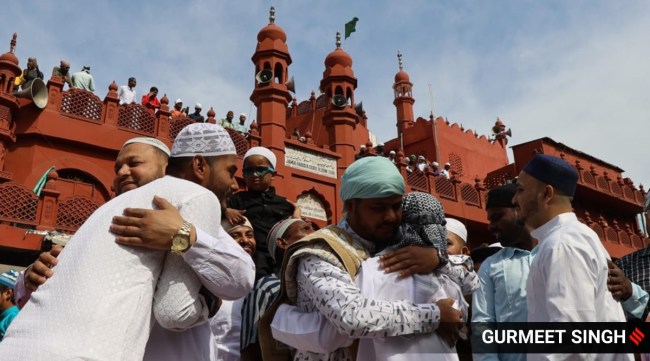Opinion Firecrackers, music and 26 types of rotis: The Indian celebration of Eid, through the ages
In each period of history, from the Tughlaqs and the Mughals to the present day, unique colours have been added to the festivities
 Eid ul Fitr is celebrated to mark the end of the holy month of Ramazan. (Express photo by Gurmeet Singh)
Eid ul Fitr is celebrated to mark the end of the holy month of Ramazan. (Express photo by Gurmeet Singh) Eid ul Fitr is celebrated to mark the end of the holy month of Ramazan. Its celebration is almost the same across the world: Offering special Eid prayers in new clothes and savouring sweet sevaiyyan (pudding made with thin noodles) or sheer and offering charity in the form of Zakat and Fitra.
In India, we celebrate Eid in a slightly different way. In the Mughal period, the sighting of the moon was greeted by the firing of cannons. Now, small but noisy fireworks have taken the place of cannons. Indian Muslims have Indianised their dress too. Some decades ago, sherwani was the most favoured attire for this occasion but it has been replaced by the modern shirt and pants. The addition of dishes like dahi bhalla, chhole bhature and sweet sheer are also influences of indigenous traditions which are unique to us. In Mumbai and Hyderabad, sheer-khurma is a special dish prepared with milk and dry dates during Eid.
 Muslims offer Eid-al-Fitr prayers to mark the end of their holy fasting month of Ramadan at Jama Masjid, in New Delhi, Saturday (Express photo by Amit Mehra)
Muslims offer Eid-al-Fitr prayers to mark the end of their holy fasting month of Ramadan at Jama Masjid, in New Delhi, Saturday (Express photo by Amit Mehra)
The 14th-century explorer Ibn-e-Batuta mentions a very interesting instance of Eid celebrations from the reign of Mohammad bin Tughlaq. This is perhaps the first mention of an Indian celebration of Eid in a non-religious text. Mohammad bin Tughlaq used to go to the Eidgah in a procession comprising 100 elephants decorated with howdahs made from gold and umbrellas of the same material. Three hundred harbingers walked ahead, led by the head verger. After offering prayers, the real celebrations would begin. The highlights were the dance and music festival, which usually lasted for two days. On the third day of Eid, the nikah of the relatives of the emperor was performed. These relatives were awarded fiefdoms and manors, which added to the joy of the festivities. On the fourth day, slaves and on the fifth day, slave girls were freed. On the sixth day, marriages of slave men and women were carried out. The seventh day, was the day of charity. During these seven days, the royal kitchen used to provide free food to the entire city.
The Mughals, who were very fond of festivities added more colours to this festival in the Indian region. Jahangir, who was known to drink alcohol, would become a teetotaller during the month of Ramazan and religiously observed all 30 fasts and would break the last one with wine. The sighting of the moon was the start of a week-long celebration. There is a painting of Emperor Jahangir and Prince Khurram at a gathering for Eid ul Fitr at the Museum Fur Islamische Kunst in Berlin which shows how music and singing were part of the celebrations in the court.
 Eid ul Fitr’s celebration is almost the same across the world (Express photo by Pavan Khengre)
Eid ul Fitr’s celebration is almost the same across the world (Express photo by Pavan Khengre)
Almost every Mughal king in India was a culinary connoisseur. This is one of the reasons why new dishes were constantly being introduced into the royal kitchen. Even in the period of the last Mughal, Bahadur Shah Zafar, who was only a titular king, the Red Fort hosted magnificent Eid celebrations. For these festivities, Zafar’s menu included 26 types of rotis and 14 types of puddings and sweet dishes.
It is strange to note that while there are many Urdu poems which describe Holi, Diwali and Moharram, there are very few poems about Eid. Still, there are some that may be referred to here:
Hilal-e-Eid jo dekha tau ye khayal hua/ Galey miley huey qatil sey ek saal hua. (Sighting the annual moon of Eid, I thought that it has already been a year since I held my beloved)
Mujh ko teri na tujhe meri khabar jaye gi/ Eid ab key bhi dabey paaon guzar jayegi (Both of us would not know about each other and this Eid too will pass us by stealthily)
Here is one of the most famous couplets by Qamar Badayuni: Eid ka din hai galey aaj toh mil ley zaalim/ Rasm-e-duniya bhi hai, mauqa bhi hai, dastoor bhi hai. (It is Eid today my beloved, let me hug you, it is condoned by custom, the occasion, and ceremony)
Lastly: Mil key hoti thi kabhi Eid bhi Diwali bhi/ Ab ye halat hai ke dar-dar key galey miltey hain. (Once we used to celebrate Eid and Diwali together, now we are so afraid of even hugging each other)
The writer is a critic, poet and literary historian






